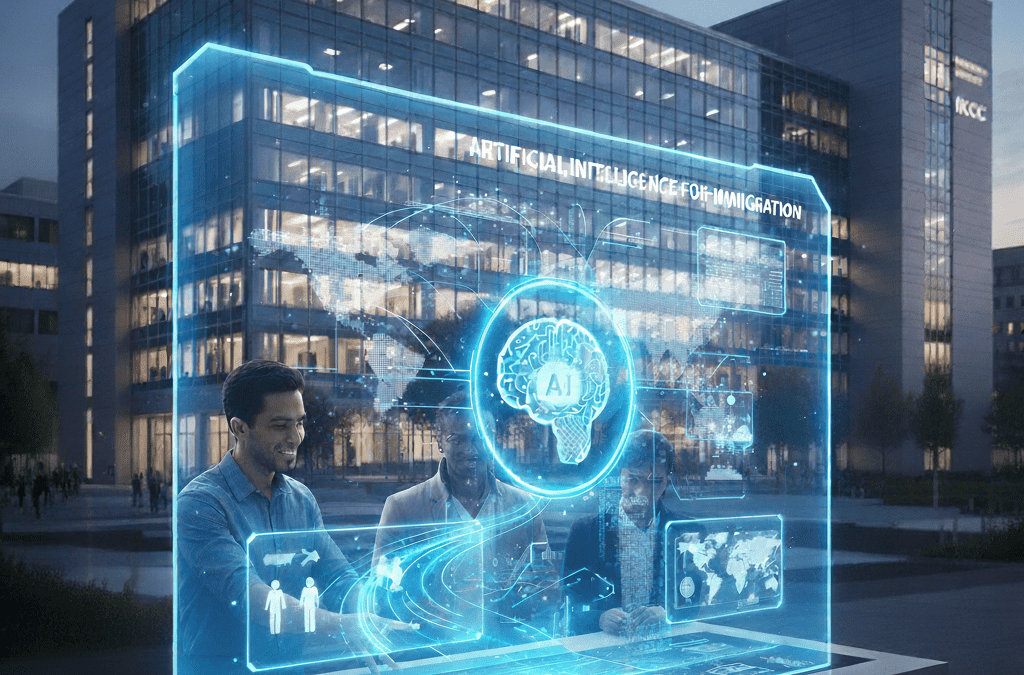Immigration, Refugees and Citizenship Canada (IRCC) has increasingly integrated artificial intelligence (AI) and automated decision-support systems into its immigration processing infrastructure. While the primary purpose has been to enhance efficiency, reduce backlogs, and address overwhelming visa application volumes, the deployment of these technologies introduces a complex web of societal, ethical, and legal considerations. This discussion outlines IRCC’s current AI deployment, the key interests in play, and the emerging tensions around privacy, surveillance, and profiling.
IRCC’s AI Deployment in Immigration Systems
IRCC AI in Canadian Immigration employs a mix of automation and AI-driven tools to triage, process, and risk-assess applications. Examples include the “Chinook” tool and the “Automated Decision Assistant” (ADA), which help officers sort temporary residence applications by highlighting routine versus complex cases and flagging issues for further review. These tools are not fully autonomous: IRCC maintains that while AI can assist in identifying risk markers or completing clerical tasks, the ultimate decision in most cases is rendered by a human officer.[1][2][3]
Efforts to formalize this digital change via IRCC AI in Canadian Immigration are guided by the Government of Canada’s broader policy frameworks for innovation and responsible AI. IRCC claims a commitment to transparency, noting that applicants should be notified when AI is involved in processing, and that policies exist for staff training and data handling. Nevertheless, public skepticism remains high, with critics highlighting the opacity of these automated systems and demanding clearer information about their internal logic, training data, and error rates.[4][5][6][7]
Societal and Legal Interests at Stake due to IRCC AI in Canadian Immigration
Efficiency vs. Fairness
- The main institutional goal is efficiency. Given the millions of applications received, AI can substantially accelerate processing, theoretically freeing up skilled officers to focus on complex or high-risk files.[2][8]
- Applicants and advocacy groups stress procedural fairness, worried that automated triaging and risk scoring could result in unexplained refusals, unjustified delays, or mistakes, especially among marginalized groups.[5][9]
Security vs. Privacy
- IRCC seeks to identify fraudulent or risky applications using sophisticated analytics—sometimes extending to social media or biometric analysis. While this can enhance security, it requires extensive data collection and surveillance capabilities.[10][11]
- Civil liberties organizations and privacy watchdogs warn about the dangers of intrusive surveillance and loss of control over one’s personal data, especially if data is retained indefinitely or used beyond original intent.[12][13]
Transparency vs. Manipulation
- Transparency is critical for the legitimacy of AI-driven decisions. Without public knowledge of how AI models operate—and the criteria or prompts they use—affected parties cannot challenge adverse results or guard against errors or system abuse.
- Conversely, authorities argue that full algorithmic disclosure could enable system “gaming,” whereby applicants tailor submissions to exploit predictable AI behaviors, potentially undermining policy intent.
Risks of Privacy Violations and Unreasonable Profiling
AI deployment in immigration is fraught with privacy and discrimination risks if not governed by strong regulatory safeguards:
- Use of biometric or facial-recognition technologies risks encoding and amplifying existing racial biases, a problem documented in both Canadian and international contexts. Without transparent oversight, AI systems can unintentionally perpetuate exclusion or target vulnerable populations for additional scrutiny.[14][15]
- If algorithms are not subject to routine auditing and third-party evaluation, hidden biases may remain undetected. Machine learning models trained on historical data inherit any prejudices embedded in those datasets, leading to the risk of systemic discrimination in applications and border control decisions.[12][10]
Requirements for Disclosure and Accountability
To address these issues, Canadian policy and privacy authorities emphasize several mandatory safeguards:
- Conduct Privacy Impact Assessments (PIAs) before deploying AI systems to process identifiable information; consult privacy officers to mitigate risks preemptively.[13][12]
- Notify users whenever AI tools are involved in their application processing; publish details about the technology, training data, and institutional policies.[4][13]
- Allow independent audits of AI decision-making pipelines and grant applicants clear avenues for appeal or review of automated decisions.[14]
- Implement de-identification, transparent retention policies, and rigorous access controls to minimize unauthorized data access or re-identification risks.[13][12]
Conclusion
IRCC AI in Canadian Immigration and automation is motivated by system efficiency, but the competing societal interests—procedural fairness, privacy, transparency—require robust legal, ethical, and technical checks. Without full disclosure of AI techniques, input prompts, and institutional safeguards, there is a tangible risk of surveillance overreach, unreasonable profiling, and a loss of public trust. Responding to these tensions demands regular public reporting, transparent operating criteria, and an unwavering commitment to the human rights and accountability standards that underpin the Canadian immigration system.[14][2][12][5]
Our firm advises clients on complex filings, requests internal records, and challenges decisions where automation may have influenced outcomes without adequate transparency. If you’re concerned that AI‑driven triage affected your application, we can help assess and respond.
- https://search.open.canada.ca/qpnotes/record/cic,IRCC – 2023-QP-00062
- https://search.open.canada.ca/qpnotes/record/cic,IRCC-2025-QP-00001
- https://www.cic.gc.ca/english/transparency/conduct.asp
- https://www.canada.ca/en/immigration-refugees-citizenship/corporate/transparency/committees/cimm-nov-29-2022/question-period-note-use-ai-decision-making-ircc.html
- https://www.canada.ca/en/immigration-refugees-citizenship/corporate/transparency/committees/cimm-nov-29-2022/question-period-note-use-ai-decision-making-ircc.html
- https://www.canada.ca/en/immigration-refugees-citizenship/corporate/transparency/committees/cimm-nov-29-2022/question-period-note-use-ai-decision-making-ircc.html
- https://www.canada.ca/en/immigration-refugees-citizenship/corporate/transparency/committees/cimm-nov-29-2022/question-period-note-use-ai-decision-making-ircc.html
- https://www.cbc.ca/news/canada/nova-scotia/immigration-canada-ircc-technology-1.7632130
- https://www.canadianlawyermag.com/practice-areas/immigration/data-security-and-bias-among-primary-concerns-with-ai-in-immigration-law-sergio-karas/374894
- https://cila.co/ai-facial-recognition-technology-in-the-canadian-immigration-system/
- https://www.priv.gc.ca/en/privacy-topics/technology/artificial-intelligence/gd_principles_ai/
- https://www.canada.ca/en/government/system/digital-government/digital-government-innovations/responsible-use-ai/guide-use-generative-ai.html
- https://lawjournal.mcgill.ca/article/the-new-jim-crow-unmasking-racial-bias-in-ai-facial-recognition-technology-within-the-canadian-immigration-system/
- https://www.erudit.org/en/journals/mlj/2024-v69-n4-mlj010082/1118429ar.pdf
- https://citizenlab.ca/2018/09/bots-at-the-gate/
- https://www.cbc.ca/news/canada/windsor/artificial-intelligence-bias-border-canada-screening-1.7624051
- https://citizenlab.ca/2018/09/bots-at-the-gate/
- https://www.cigionline.org/articles/using-ai-immigration-decisions-could-jeopardize-human-rights/
- https://www.research.aqmen.ac.uk/wp-content/uploads/sites/38/2021/06/Paper-for-University-of-Edinburgh-Workshop-on-Artificial-Intelligence-and-Border-Control-June-2021.pdf

